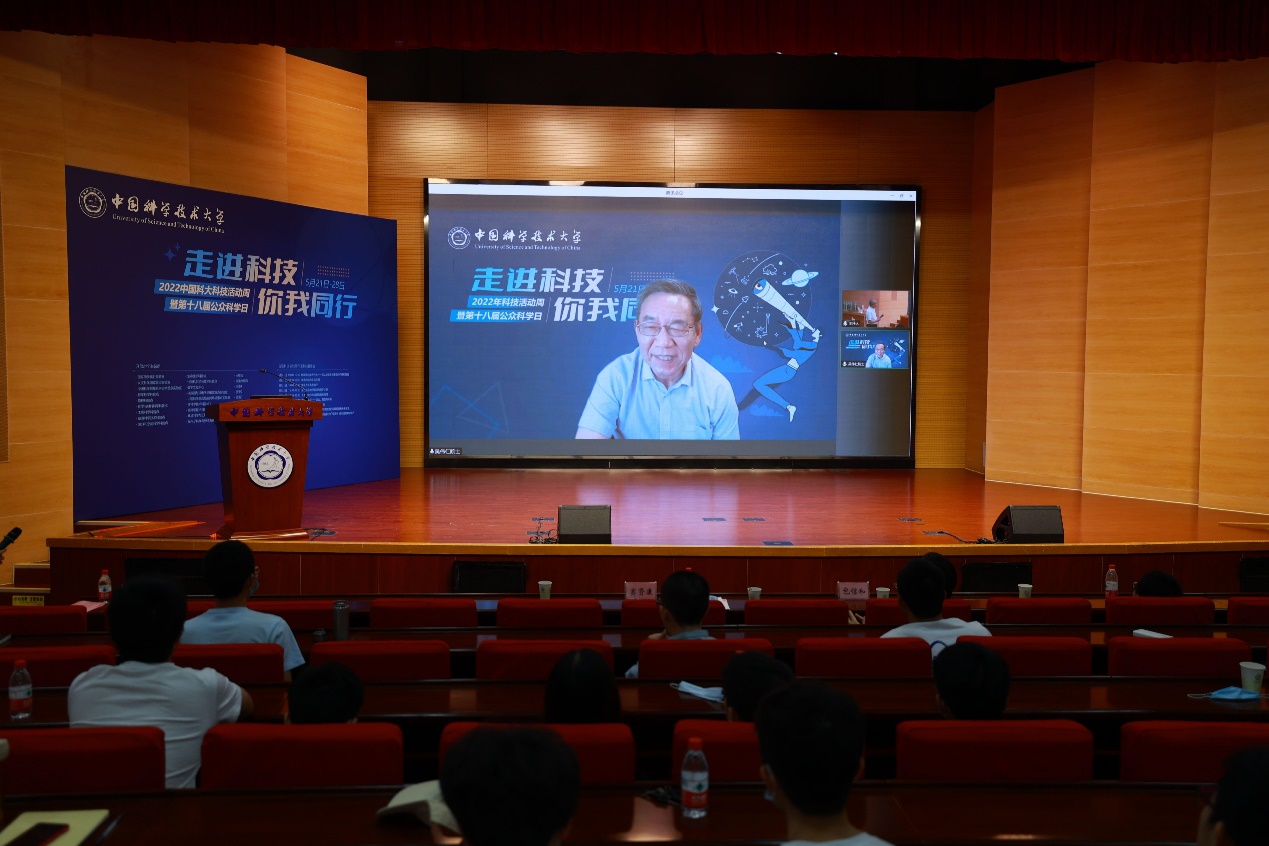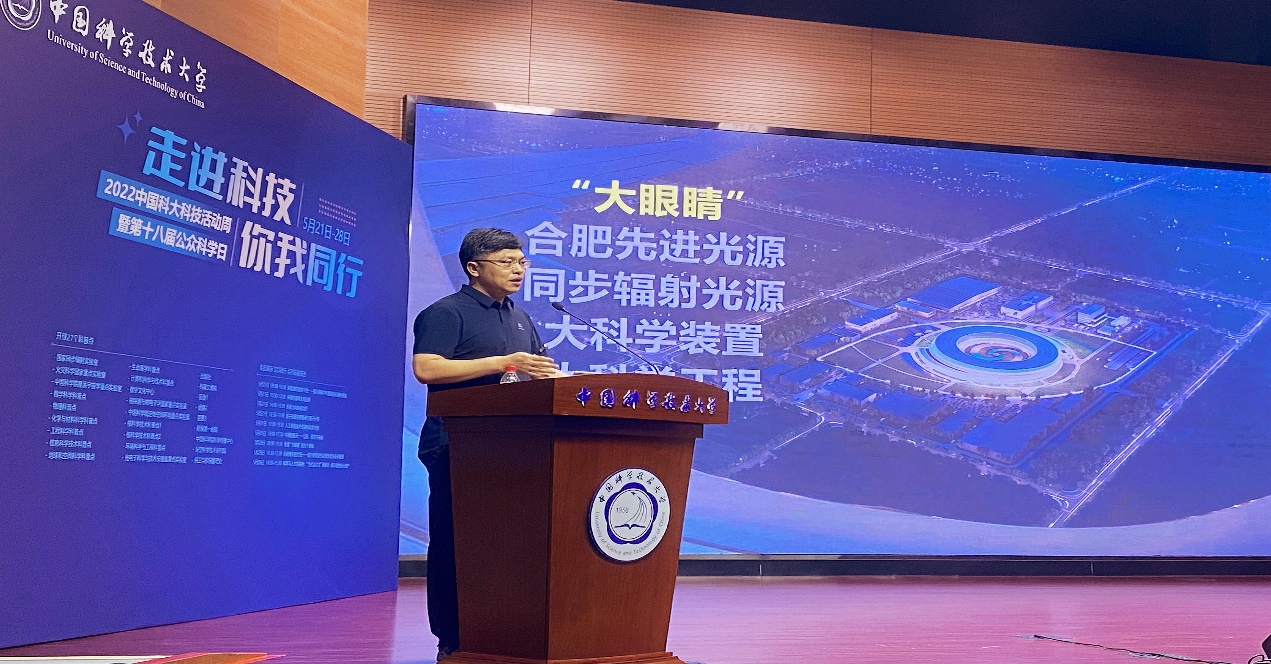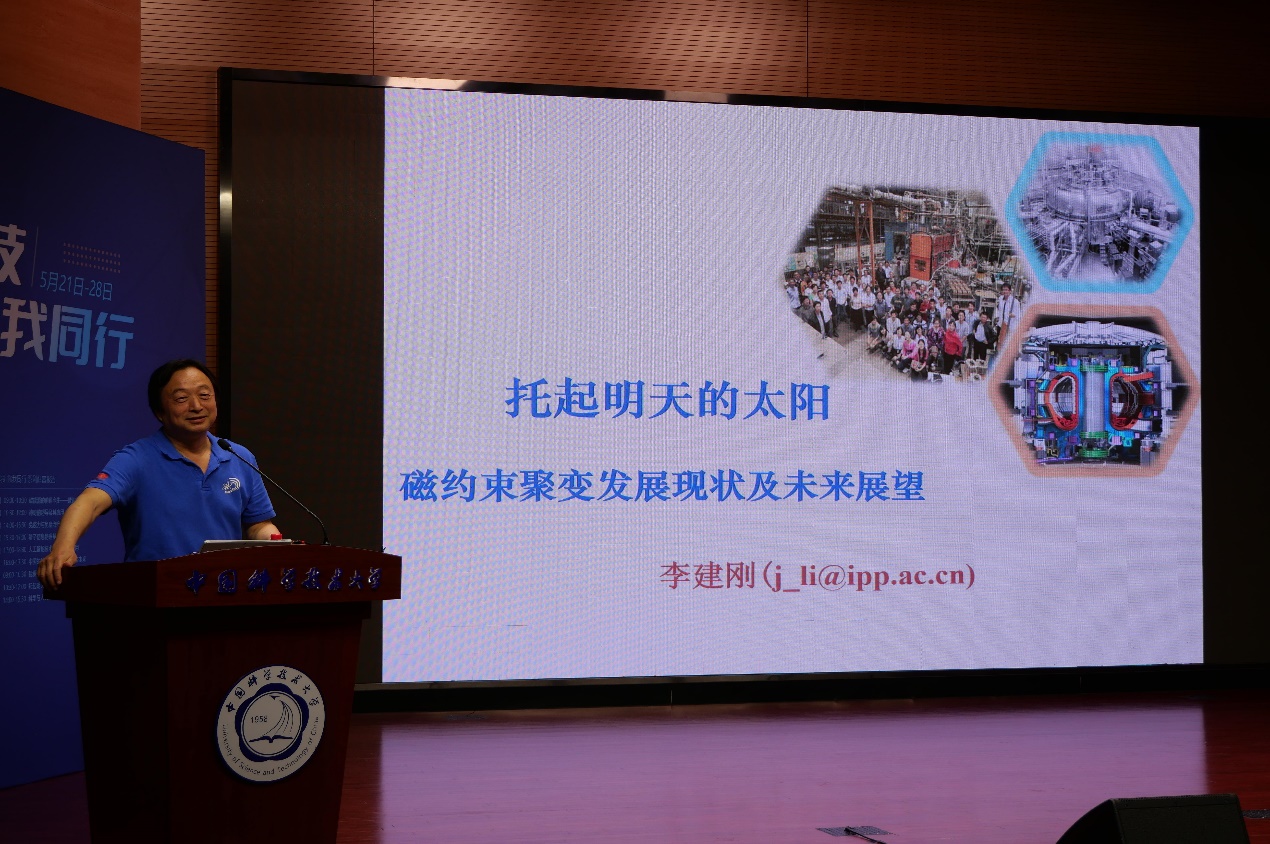On May 25 and May 28, the second phase of science popularization lectures was held as scheduled at the University of Science and Technology of China (USTC).
WU Weiren: Looking up to the stars and sky to build a spaceflight power
At the lecture, WU Weiren, an academician of the Chinese Academy of Engineering and chief designer of China’s lunar exploration project, gave a report on “China’s Spaceflight - Past, Present and Future”, in which he analyzed the new trends in world spaceflight, introduced the new progress of China’s spaceflight, and summarized the new achievements of China’s lunar and planetary exploration and other major projects. He also proposed making the Deep Space Exploration Laboratory an important talent center and innovation hotspot with international influence.

WU Weiren, chief designer of China’s lunar exploration project, is giving the lecture online.
He pointed out characteristics of world space development nowadays: the more prominent strategic position of space and innovation; the increasingly intense competition of outer space governance; the accelerated development of commercial space; and the emerging popularity of deep space exploration in space activities.
Over the past 60 years of remarkable development since the space industry was established in 1956, China has made great achievements in this area, including artificial satellites, manned spaceflight, lunar exploration, and Mars exploration. It has opened up a path of self-reliance and independent innovation, and created the spirit of China’s space industry. President XI Jinping has attached great importance to the development of the space industry, calling for “the comprehensive development of space science, space technology, and space applications.”
WU reckoned that, China’s spaceflight has generally achieved “four changes,” namely, the significant increase in scientific and technological innovation capabilities; the complete support for space engineering systems from traditional to modern modes; the great improvement in space application service capabilities from experimental to operational applications; and the deepened and expanded open cooperation from serving domestically to benefiting the whole of mankind.
China’s international influence and discourse in space are increasing. China’s major space projects continue to wow the world, such as the completion of three steps (“circle, fall, and return”) of the lunar exploration project; the successful landing of China’s Tianwen 1 spacecraft on the Mars surface; the full transfer of manned space engineering mission to the construction stage; the global networking of the BeiDou-3 system; and the space-based section of the China High-resolution Earth Observation System, which has been largely completed, enabling high-spatial-resolution, high-temporal-resolution and high-spectrum-resolution earth observation.
FENG Donglai: Nine reasons why I love “Big Eye”
Synchrotron radiation devices are known as the “lighthouse” of science and technology, and they provide a platform to support multidisciplinary frontier research and industrial development. Currently, the National Synchrotron Radiation Laboratory of USTC is building the next generation of synchrotron radiation device - Hefei Advanced Light Source (HALS), which is also known as the “Big Eye”. After its completion, it will become an internationally advanced and Asia’s only fourth-generation synchrotron light source in the low-energy region.

FENG Donglai, director of the National Synchrotron Radiation Laboratory, is giving the lecture.
At the lecture, FENG Donglai, director of the National Synchrotron Radiation Laboratory, delivered a report on “Nine Reasons Why I Love ‘Big Eyes’”. He said, “We are building and using an instrument that combines the best of human technology. This is the first reason.”
Science has selected some relevant reasearch covering chemistry and energy, life science, physics from 125 major scientific questions. FENG said that all these problems can be further studied through synchrotron radiation. This is the second reason – “to do cutting-edge research”.
Neurodegenerative diseases are the great enemies of human beings, among which Alzheimer’s disease has 50 million patients worldwide and 10 million in China, and it is growing explosively. He said, “in the past 20 years, 320 drugs have been tried but failed. HLAS can increase the three-dimensional imaging rate of cells to a few nanometers, thus understanding the pathology.”
The third reason is “to do research and development with real use.” For example, using HLAS, researchers have discovered combustion intermediates, explaining the combustion reaction path and its kinetics; they have detected the key intermediates of coal-based syngas to olefins, breaking the traditional Fischer-Tropsch limit ......
The fourth reason is “not limited to a certain method or discipline”. The battery problem of electric vehicles can be studied by researchers using different means. The fifth reason is the “natural world laboratory and international cooperation network.” He said that “synchrotron radiation device will be open to scientists around the world, and researchers can choose the most appropriate tools according to their own research problems.”
Other reasons for loving “Big Eye” include “stable support for long-term technical research; a wide range of technical disciplines; the ability to manage organizations and projects; and the passion and sense of accomplishment that comes with big science projects.”
LI Jiangang: How to ignite the “artificial sun”? [the Experimental Advanced Superconducting Tokamak (EAST)]
How will mankind sustain itself in the future when fossil energy is depleted? LI Jiangang, Dean of the School of Nuclear Science and Technology, believes that nuclear fusion energy is an inexhaustible new energy.

LI Jiangang, Dean of the School of Nuclear Science and Technology, is giving the lecture.
In the lecture, he gave a report on “Holding up the future’s sun – the current status and future prospect of magnetic confinement fusion”, in which he highlighted the world’s first fully super-conducting tokamak designed and built by China; China’s participation in the international thermonuclear fusion reactor program; the future plan to independently build China’s fusion engineering reactor; and the outlook on future clean energy.
According to Einstein’s special theory of relativity, mass is a measure of the total energy of a system (E=mc2), which means that energy equals mass multiplied by the speed of light squared. This is the principle of the use of nuclear energy.
Fusion and fission are two completely different forms of nuclear reactions. When a large atomic nucleus is cracked open to release energy, fission is to produce atomic bomb, while fusion is for producing hydrogen bomb. The operating principle of the latter is to add a small amount of the hydrogen isotope deuterium or tritium to the device’s vacuum chamber and generate plasma through a transformer-like principle, thus increase its density and temperature to cause a fusion reaction – a process that generates enormous energy.
But causing a fusion reaction is quite difficult. He said, first of all, it must be ignited to hundreds of millions of Celsius for fusion to occur, and secondly, to achieve a long-time continuous operation of controlled fusion is not that easy.
“The solution is magnetic levitation, using a large (roughly 5 tesla) magnetic field to confine a hot plasma while steadily supplying heat to compensate for energy losses. This method is called ‘tokamak’.”
The ultimate goal of “artificial sun” is to generate electricity. When can we really have fusion power? LI said, “Through the development of three stages of fusion experimental reactors, engineering demonstration reactors and commercial reactors in the next 10-20 years, we can gradually utilize nuclear fusion energy.”
ZHOU Zhonghe: The future of mankind must be inseparable from the blend of science, humanities and society
Edward Wilson is known as “contemporary Darwin”, “Darwin's heir”, “king of ants”, “father of sociobiology”, “Father of Biodiversity” ... In 1996, Wilson was named by Time as one of the 25 most influential Americans. Nature described him as “not only a world-class master of science, but also a great writer.”
Wilson wrote in his autobiography, Naturalist, “Most children have a bug period. I never grew out of mine.” It was with the study of ants that Wilson began his scientific career.
Wilson discovered more than 400 species of ants during his lifetime, and through collaboration with chemists and mathematicians, he decoded the chemical code of ant communication. “The study of ant island biogeography, which laid the foundation for conservation biology, is one of the most important intellectual legacies left by Wilson.” said ZHOU Zhonghe, Dean of the School of Humanities and Social Sciences.
In 1975, Wilson published Sociobiology. ZHOU said, “it first proposed and named the discipline of sociobiology, gave birth to evolutionary psychology, and established Wilson’s position as the father of sociobiology.”
It was from this book that Wilson extended the achievements of sociobiology to sociological anthropology. However, the last chapter of the book caused much controversy as it presented the biological basis of many human social behaviors.
Fortunately, science has stood the test of time. In 1995, Sociobiology was selected by the Animal Behavioral Society as “the most important work on animal behavior ever.” “Sociobiology is the second most important intellectual legacy left by Wilson, and the blend of science and humanities is the third,” he said.
Reproduction of offspring is one of life’s most important characteristics. ZHOU thinks that there are also two other important relationships that have been running through the whole process of life evolution. One is the relationship between heredity and environment, which is the relationship between genes and culture for humans, and the other is the relationship between the individual and the group. ZHOU said, “The future of mankind must be inseparable from the blend of science, humanities, and society.”
BAO Xinhe, President of USTC, pointed out in his concluding speech that, as the highlight of the Science and Technology Week, a series of nine science popularization lectures were successfully held and broadcast live online, arousing public enthusiasm and students’ interest in science. USTC will always uphold its mission, actively assume the responsibility of popularizing scientific knowledge, spreading scientific ideas and promoting scientific spirit, and contributing to our science and technology power.
(Written by DUAN Qingrong, edited by LI Xiaoxi, USTC News Center)